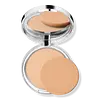What's inside
What's inside
 Key Ingredients
Key Ingredients

 Benefits
Benefits

 Concerns
Concerns

 Ingredients Side-by-side
Ingredients Side-by-side

Synthetic Fluorphlogopite
Magnesium Potassium Fluorosilicate
AbrasiveBoron Nitride
AbsorbentAluminum Starch Octenylsuccinate
AbsorbentAluminum Hydroxide
EmollientOctyldodecyl Stearoyl Stearate
EmollientHydrogenated Vegetable Oil
EmollientSilica
AbrasiveDimethicone
EmollientIllite
AbrasiveZinc Stearate
Cosmetic ColorantDicalcium Phosphate
AbrasivePentaerythrityl Tetraisostearate
EmollientSilybum Marianum Seed Oil
Skin ConditioningNannochloropsis Oculata Extract
HumectantAlaria Esculenta Extract
Skin ProtectingPorphyra Umbilicalis Extract
Skin ConditioningRosa Hybrid Flower Extract
Skin ConditioningCaprylic/Capric Triglyceride
MaskingCaprylyl Glycol
EmollientBisabolol
MaskingEthylhexylglycerin
Skin ConditioningKaolin
AbrasiveMica
Cosmetic ColorantTriethoxycaprylylsilane
Sorbitan Tristearate
EmulsifyingPentaerythrityl Tetra-Di-T-Butyl Hydroxyhydrocinnamate
AntioxidantTocopherol
AntioxidantCI 77891
Cosmetic ColorantCI 77491
Cosmetic ColorantCI 77492
Cosmetic ColorantCI 77499
Cosmetic ColorantCI 77163
Cosmetic ColorantCI 77289
Cosmetic ColorantCI 77288
Cosmetic ColorantCI 77510
Cosmetic ColorantCI 77742
Cosmetic ColorantCI 15850
Cosmetic ColorantCI 77007
Cosmetic ColorantCI 42090
Cosmetic ColorantCI 45410
Cosmetic ColorantCI 73360
Cosmetic ColorantCI 19140
Cosmetic ColorantCI 15985
Cosmetic ColorantSynthetic Fluorphlogopite, Magnesium Potassium Fluorosilicate, Boron Nitride, Aluminum Starch Octenylsuccinate, Aluminum Hydroxide, Octyldodecyl Stearoyl Stearate, Hydrogenated Vegetable Oil, Silica, Dimethicone, Illite, Zinc Stearate, Dicalcium Phosphate, Pentaerythrityl Tetraisostearate, Silybum Marianum Seed Oil, Nannochloropsis Oculata Extract, Alaria Esculenta Extract, Porphyra Umbilicalis Extract, Rosa Hybrid Flower Extract, Caprylic/Capric Triglyceride, Caprylyl Glycol, Bisabolol, Ethylhexylglycerin, Kaolin, Mica, Triethoxycaprylylsilane, Sorbitan Tristearate, Pentaerythrityl Tetra-Di-T-Butyl Hydroxyhydrocinnamate, Tocopherol, CI 77891, CI 77491, CI 77492, CI 77499, CI 77163, CI 77289, CI 77288, CI 77510, CI 77742, CI 15850, CI 77007, CI 42090, CI 45410, CI 73360, CI 19140, CI 15985
Talc
AbrasiveIsostearyl Linoleate
EmollientTitanium Dioxide
Cosmetic ColorantOctyldodecyl Stearoyl Stearate
EmollientTocopherol
AntioxidantHydrogenated Lecithin
EmulsifyingTrimyristin
Skin ConditioningAlumina
AbrasiveMethicone
EmollientTetrasodium EDTA
Phenoxyethanol
PreservativePotassium Sorbate
PreservativeMica
Cosmetic ColorantIron Oxides
CI 77742
Cosmetic ColorantCI 73360
Cosmetic ColorantCI 75470
Cosmetic ColorantCI 77163
Cosmetic ColorantCI 15850
Cosmetic ColorantCI 77007
Cosmetic ColorantCI 77891
Cosmetic Colorant
 Reviews
Reviews

Ingredients Explained
These ingredients are found in both products.
Ingredients higher up in an ingredient list are typically present in a larger amount.
Ci 15850 is the pigment color red. It is an azo dye and created synthetically.
Azo dyes need to be thoroughly purified before use. This allows them to be more stable and longer-lasting.
This ingredient is common in foundations, lipsticks, and blushes. This color is described as brown/orangey red.
It has many secondary names such as Red 6 and Red 7. According to a manufacturer, Red 6 usually contains aluminum.
Learn more about CI 15850Ci 73360 is a synthetic red-pink dye.
This pigment is called Ultramarine blue lazurite. It gives a saturated blue color, but can be used to create other colors as well.
According to the manufacturer, it is usually made from kaolin, sodium sulfate, sodium carbonate, sulfur, and charcoal.
This synthetic powder is used to add a pearly/white color in cosmetics.
This ingredient is used to add a violet color to cosmetics.
It is created by reacting phosphoric acid, ammonium dihydrogen orthophosphate, and manganese dioxide.
Ci 77891 is a white pigment from Titanium dioxide. It is naturally found in minerals such as rutile and ilmenite.
It's main function is to add a white color to cosmetics. It can also be mixed with other colors to create different shades.
Ci 77891 is commonly found in sunscreens due to its ability to block UV rays.
Learn more about CI 77891Mica is a naturally occurring mineral used to add shimmer and color in cosmetics. It can also help improve the texture of a product or give it an opaque, white/silver color.
Serecite is the name for very fine but ragged grains of mica.
This ingredient is often coated with metal oxides like titanium dioxide. Trace amounts of heavy metals may be found in mica, but these metals are not harmful in our personal products.
Mica has been used since prehistoric times throughout the world. Ancient Egyptian, Indian, Greek, Roman, Aztec, and Chinese civilizations have used mica.
Learn more about MicaOctyldodecyl Stearoyl Stearate is created from stearic acid.
It is an emollient and thickens the lipid (oil) portion of a product. Due to its emollient properties, it may not be fungal-acne safe.
Tocopherol (also known as Vitamin E) is a common antioxidant used to help protect the skin from free-radicals and strengthen the skin barrier. It's also fat soluble - this means our skin is great at absorbing it.
Vitamin E also helps keep your natural skin lipids healthy. Your lipid skin barrier naturally consists of lipids, ceramides, and fatty acids. Vitamin E offers extra protection for your skin’s lipid barrier, keeping your skin healthy and nourished.
Another benefit is a bit of UV protection. Vitamin E helps reduce the damage caused by UVB rays. (It should not replace your sunscreen). Combining it with Vitamin C can decrease sunburned cells and hyperpigmentation after UV exposure.
You might have noticed Vitamin E + C often paired together. This is because it is great at stabilizing Vitamin C. Using the two together helps increase the effectiveness of both ingredients.
There are often claims that Vitamin E can reduce/prevent scarring, but these claims haven't been confirmed by scientific research.
Learn more about Tocopherol